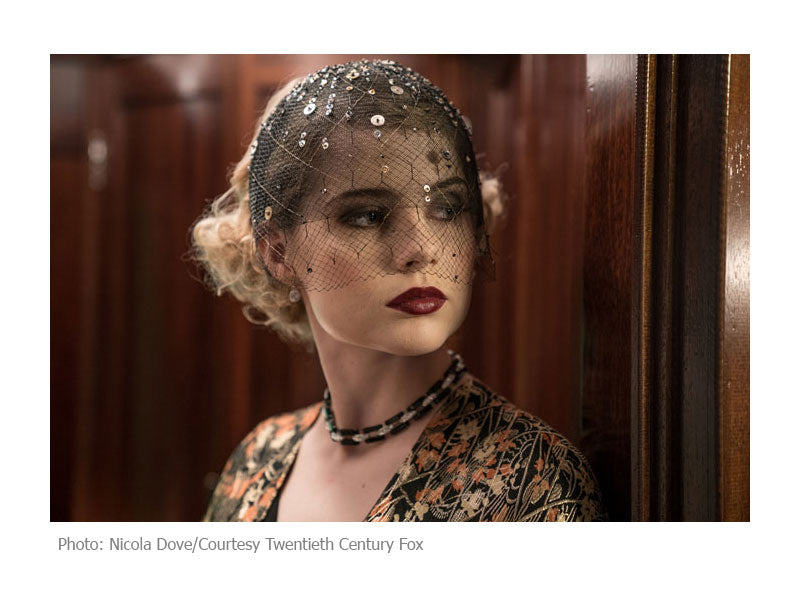 I love mysteries almost as much as I love jewelry. In fact, I was a dedicated collector of this genre featuring female detectives before I devoted my collecting efforts solely to jewelry. So, imagine my delight when I went to see a new production of Murder on the Orient Express, based on the novel by Agatha Christie and directed by Kenneth Branagh. With an all-star cast, it delivered Art Deco splendour on the big screen. And I even recognized a 1930s Art Deco necklace. What could be better?
I love mysteries almost as much as I love jewelry. In fact, I was a dedicated collector of this genre featuring female detectives before I devoted my collecting efforts solely to jewelry. So, imagine my delight when I went to see a new production of Murder on the Orient Express, based on the novel by Agatha Christie and directed by Kenneth Branagh. With an all-star cast, it delivered Art Deco splendour on the big screen. And I even recognized a 1930s Art Deco necklace. What could be better?
The Movie
Set in 1934, the story begins with Hercule Poirot (Branagh) at breakfast in Jerusalem. The obsessively-meticulous, mustachioed Belgian detective is traveling to Istanbul en route to a vacation. He abandons his plans when he is summoned to London immediately to consult on a pressing case. In a café, he runs into his friend M. Bouc, director of the Orient Express, who assures him a room on the train leaving for Paris that evening.
On board, Poirot meets the other 13 travelers: an American businessman, his English butler, and American secretary; a Russian princess and her German maid; a Spanish missionary; a Hungarian count and countess; an American widow; an Austrian professor; an English physician; a Cuban-American car salesman; and an English governess.
Samuel Ratchett (Johnny Depp), the businessman, has received threatening letters. He offers Poirot a job as his bodyguard, but the detective refuses. After retiring for the night, he hears strange noises coming from Ratchett’s compartment. When Poirot opens his door to look for the source, he sees someone in a red kimono running down the hallway. During the night, an avalanche derails the train’s engine, and the passengers are stranded. The next morning, everyone learns that Ratchett was murdered. Poirot and Bouc investigate, while awaiting the arrival of railroad staff to repair the train.
What follows is the unravelling of the mystery. Not one of the travelers is who she or he claims to be. A seemingly-random assembly of passengers turns out to be anything but that. I won’t spoil the movie by revealing more of the plot, in case you don’t already know the story. What’s more important to me, anyway, is to tell you about the Art Deco jewelry, costumes, and set!
The Necklace

One of the 12 suspects is the Hungarian countess. Here’s what writer Valentina Valentini and costume designer Alexandra Byrne said about the character and her wardrobe in an interview for Vanity Fair: “The Countess Antrenyi, played by Lucy Boynton, is a nocturnal woman. She takes barbital to rest during the day, and spends most of her time trying to avoid life.
‘I wanted to elicit a feeling of a slightly damaged butterfly when it came to the countess,’ says Byrne. ‘She’s a dancer and very elegant; she’s wealthy, but she really doesn’t know day from night, so all her clothes get a little bit mixed up.'
“Byrne wanted to make sure that when she boarded the train in Istanbul, the Countess would look fairly put together. But once on the train, she’d be in a pajama suit with a gauze robe.”
This photo shows how beautifully “put together” the Countess looks when we first see her with her dancer husband. She is wearing a gorgeous red, black, and gold lamé coat over a black dress. According to the same interview, Byrne struck gold when she found the 1930s fabric in fabulous condition.

The Set
Production designer Jim Clay and his team created two replicas of the sleeping compartments and dining cars of the legendary and luxurious passenger train, for the 13-week production in London. Every detail – from the table linens, china, and crystal, to the light fixtures and wall treatments – was recreated in the geometric Art Deco style rather than the “more floral Art Nouveau style of the original Express,” said Clay (in an interview for Hollywood Reporter). Branagh added: “It's attention to detail in the golden age of travel. It’s about feeling the quality of the crisp linens and an appreciation of the finer things that represents a level of craftsmanship and history.”
More About The Costumes
Oscar-winning Alexandra Byrne spent a lot of time researching the aesthetic of the mid-1930s in preparation for the film. In addition to wanting to convey the glamour of the era, she also had to create back-stories for each of the characters. “None of the characters are depicted as the persons you first meet,” says Byrne (in the Hollywood Reporter interview). “Kenneth wanted me to collect a world history of these characters and lay clues for people to find. We needed to know how they would have decided to dress as somebody else and what resources they would have had to put that together.”
Speaking about the men’s costumes, Byrne said: “There are many differences between American, English and European tailoring in the '30s. Trouser pleats on American trousers were set turned out, and English turned in; American suits were usually made from a lightweight cloth. Hardman’s [Willem Dafoe’s] suit is made from a coarse, heavyweight, gray wool cloth, and the style is influenced by earlier European hunting jackets.” He is dressed in the type of three-piece, belted suit an Austrian of that era would have worn.
Costumes for one of the female leads were inspired by couturiers of the period. Speaking of Princess Dragomiroff (Judi Dench), Byrne commented: “She is a wealthy Russian princess in exile who would visit the fashion houses, so I looked to Lanvin for influence.” The designer’s favorite character to dress was Caroline Hubbard (Michelle Pfeiffer), who has “a blind eye to the notion that ‘less is more.’” As a lover of costume jewelry, I’m not so sure Hubbard’s style is over-the-top. But I’m pretty sure she was wearing a Miriam Haskell brooch at the throat of her embroidered dress, in the scene when the train leaves the station. You’ll have to see the film, and decide for yourself!

7 comments
Thank you for your compliments. I nearly fainted when I recognized the necklace in Murder on the Orient Express, as I was working on the Schreiber & Hiller article at the time. I appreciate praise from another vintage costume jewelry aficionado. Looking forward to the release of Death on the Nile.
“I’ve enjoyed reading your information. I would like to say that Jewels Past supplied this necklace, which also had a matching bracelet, this was bought by one of the producers Alexander, along with many other items for this film. I compliment you on finding out so much information on the designer and the film.
Jewels Past has also supplied the jewellery for the Death on the Nile which is currently in production. They have bought a lot of Jakob Bengel jewellery as well as bakelite and flapper necklaces. So look out for more fabulous Art Deco jewellery in this brilliant film with some surprising brilliant actors."
You’re welcome! Thanks for writing. Regards, Barbara
Barbara, thank you for providing more of the back story of this this movie regarding the jewelry, clothes, etc. in the Art Deco era. I found that the movie was a visual delight. Thanks for sharing.
I, too, had seen other versions, but I can never resist seeing a good production of anything set in the Art Deco era. In fact, I went back to see Branagh’s film a second time before writing about it. You won’t be sorry! Best wishes, Barbara
Leave a comment